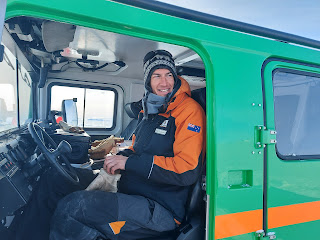What to do with extraordinary sea ice conditions?
This year's local sea ice coverage is a bit different from 'usual'. Sea ice is the ice that forms when the air temperatures get so cold that the surface of the ocean freezes. This happens at both ends of the earth. But in the Southern Ocean, such a large area freezes that it effectively doubles the size of Antarctica each winter. This is huge, especially when one realises that Antarctica is already 50x the size of New Zealand!
You can think of sea ice like a great big flat, white ship that is currently securely moored to the land. But as summer comes on, that 'ship' will break up and sail away, allowing us only a fixed window of time in which it is safe to do our science. Actually, we're using this to our advantage – before we head home, we'll be placing instruments out on the ice that will float north with it and transmit their position daily as they drift away from the land to circle around Antarctica. This will give us real-time information about how the sea ice is moving!
Where we are in McMurdo Sound, the ocean generally starts to freeze up in March and we end up with 50 – 100 km range to work on by the time we arrive in October. The thickness, roughness, and extent of the sea ice is strongly controlled by the weather conditions through the preceding winter. This year, a series of strong southerly storms kept rolling through on an almost weekly basis throughout the winter. So, the newly-forming sea ice kept getting blown out before it had a chance to settle and solidify. This continued to the point where, even as far into the season as late-August, nearly all of McMurdo Sound was open water – a situation so unusual that nothing like it has been seen in the entire satellite record of over 40 years.
The result is that the sea ice at our intended site (~30 km from Scott Base) is far too thin to support our container camp. Instead, we are camping on the only patch of sea ice that has been continuously growing since March, leaving us only ~6 km from Scott Base. This is a very different scenario to what we had planned. But it does offer us a unique opportunity to get a glimpse into the future – when we might expect the sea ice to form later in the year or to not grow as thick as it usually does now.
A quick change of plans means that we are now focusing our field work around documenting the effect of the unusual sea ice conditions on formation of the sub-ice platelet layer and the knock-on effects for the ecosystem. So, we'll be taking complementary samples from both the 'old' ice near our camp and the 'new' ice further out in McMurdo Sound so that we can compare 'mature' and 'nascent' platelet layers. It will be interesting to bring our data home to analyse, and then to compare them with results from a separate study into the drivers behind this unusual winter.
Sent from Iridium Mail & Web.
You can think of sea ice like a great big flat, white ship that is currently securely moored to the land. But as summer comes on, that 'ship' will break up and sail away, allowing us only a fixed window of time in which it is safe to do our science. Actually, we're using this to our advantage – before we head home, we'll be placing instruments out on the ice that will float north with it and transmit their position daily as they drift away from the land to circle around Antarctica. This will give us real-time information about how the sea ice is moving!
Where we are in McMurdo Sound, the ocean generally starts to freeze up in March and we end up with 50 – 100 km range to work on by the time we arrive in October. The thickness, roughness, and extent of the sea ice is strongly controlled by the weather conditions through the preceding winter. This year, a series of strong southerly storms kept rolling through on an almost weekly basis throughout the winter. So, the newly-forming sea ice kept getting blown out before it had a chance to settle and solidify. This continued to the point where, even as far into the season as late-August, nearly all of McMurdo Sound was open water – a situation so unusual that nothing like it has been seen in the entire satellite record of over 40 years.
The result is that the sea ice at our intended site (~30 km from Scott Base) is far too thin to support our container camp. Instead, we are camping on the only patch of sea ice that has been continuously growing since March, leaving us only ~6 km from Scott Base. This is a very different scenario to what we had planned. But it does offer us a unique opportunity to get a glimpse into the future – when we might expect the sea ice to form later in the year or to not grow as thick as it usually does now.
A quick change of plans means that we are now focusing our field work around documenting the effect of the unusual sea ice conditions on formation of the sub-ice platelet layer and the knock-on effects for the ecosystem. So, we'll be taking complementary samples from both the 'old' ice near our camp and the 'new' ice further out in McMurdo Sound so that we can compare 'mature' and 'nascent' platelet layers. It will be interesting to bring our data home to analyse, and then to compare them with results from a separate study into the drivers behind this unusual winter.
Sent from Iridium Mail & Web.



Comments
Post a Comment